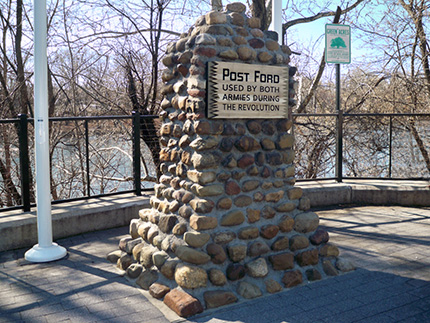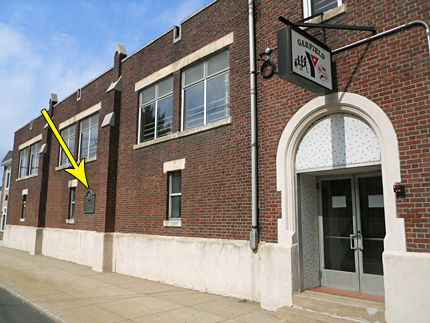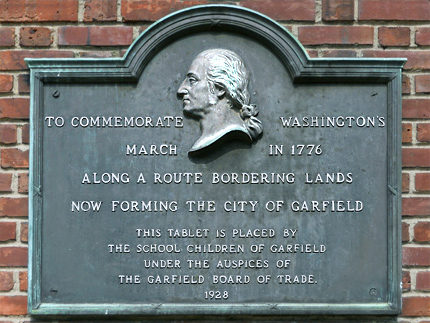







Post Ford Monument
River Rd. and Columbus Ave.
Map / Directions to the Post Ford Monument
Map / Directions to all Garfield Revolutionary War Sites
Post Ford
The Post Ford monument marks the site where British and Hessian soldiers crossed the Passaic River from Garfield on November 26, 1776, in pursuit of Washington’s army. On November 21, after Washington's retreating army had crossed the Acquackanonk Bridge over the Passaic River, the bridge was destroyed. After the pursuing British arrived and found that the bridge had been destroyed, they located a spot at Adrian Post’s farm and grist mill where the river could be forded. (A ford is the term for a shallow spot in a river where it can be crossed on foot or horseback.) However, the river was running high due to several days of steady rain, so they decided to wait several days for the water level to go down before finally crossing on November 27. The local farmers, who had been robbed of possessions by the British soldiers, were happy to see them go. It is believed that all of the local farmers supported the American cause, with the exception of one Tory. [1]
Backstory
April - November 1776
Brooklyn, Manhattan, Fort Lee, and the Retreat Across New Jersey [2]
George Washington was named the head of the Continental (American) Army by Congress on June 15, 1775. His first task was to travel to Philadelphia from Boston. The Continental Army achieved an early victory in Boston, with a successful siege that drove British forces from the city. The next chapter would prove to be much more difficult, and nearly disastrous to the Continental Army.
After British forces were driven from Boston in March 1776, General Washington headed to New York City, where he arrived on April 13, 1776. The task for him and his army was to protect New York from British invasion. The city was of great strategic importance, and New York harbor offered control of the Hudson River. The British had a large and powerful navy, and their strategy was to use their ships to gain control of the Hudson River in order to split the thirteen colonies in two.
On June 29, British ships began arriving in the New York harbor. Over the next two months, a steady stream of additional ships would arrive, carrying more and more British and Hessian troops. (Hessians were German mercenary soldiers hired by the British to fight in the war.)
While the main body of Washington's army was on Manhattan and Long Island, work began on a fort here in July 1776, which was originally called “Fort Constitution.” It would later be renamed “Fort Lee” in honor of General Charles Lee. Across the Hudson River, another fort called Fort Washington had already been constructed. The idea was that these two forts on opposite sides of the river could be used to stop British ships from sailing up the Hudson River.
On July 4, the Declaration of Independence was adopted by the Continental Congress in Philadelphia, raising the stakes of the war. British ships continued to sail into New York harbor throughout the summer, bringing a total of more than 31,000 British and Hessian troops. This was the largest invading force in history up to that time. As the British and Hessian forces continued to grow on Staten Island, General Washington was uncertain as to where they would attack first. He therefore kept some of his troops on Manhattan Island and some in Brooklyn on Long Island.
The first test for the effectiveness of Fort Washington came when two British ships, the Rose and the Phoenix, sailed up the Hudson River on July 12. Cannon fire from Fort Washington made little impact; the two ships suffered no serious damage, and no casualties. Despite these poor results, General Washington stuck to the plan of defending the river with the forts, and so work continued to complete Fort Lee.
The initial attack by British and Hessians came on Long Island on August 22, in which the Americans were forced to evacuate defenses they had spent months building. Over the following weeks, the Continental Army suffered a series of defeats and retreated north across Manhattan. By the end of September, British were in control of all of Manhattan, except Fort Washington.
The decision was made to defend Fort Washington, even though its effectiveness had been shown to be ineffective in its purpose of stopping British ships from sailing past it on the Hudson River.
On November 16, British and Hessian troops attacked Fort Washington, easily and quickly overrunning its defenses and capturing 2,800 American troops. Washington ordered General Nathanael Greene to manage an evacuation of Fort Lee, while Washington himself was headquartered ten miles away at the Zabriskie house in Hackensack. [3] A surprise invasion several days later would keep the evacuation from being an orderly one.
On the night of November 19-20, 5000 British and Hessian forces under General Cornwallis crossed over the Hudson River, disembarking about six miles north of Fort Lee at Lower Closter Landing. Upon learning of the invasion, the American troops at Fort Lee made a hasty evacuation, leaving behind such important items as tents, entrenching tools, heavy artillery, and a large amount of food. This began a twelve-day retreat across New Jersey, which would end on December 2 when they reached Trenton, where they spent five days moving all the troops and supplies across the Delaware River into Pennsylvania.
It was during this retreat across New Jersey that the Continental Army crossed the Acquackanonk Bridge over the Passaic River, and then destroyed the bridge to prevent their pursuers from using it to cross the river. Without being able to use that bridge, the British and Hessian soldiers needed to find a shallow part of the river to cross, and they used the spot which is now commemorated by the Post Ford Monument.
This was a desperate time for General Washington and his army, what Thomas Paine would describe as "These are the times that try men's souls." [4] Washington himself wrote in a letter to his brother John after the fall of Fort Washington, "I am wearied almost to death with the retrograde motion of things." [5]
However, within weeks Washington and his army would turn the tide. On Christmas night, Washington's forces crossed the Delaware River back into New Jersey, where they would win a small but important victory the next morning at Trenton, followed a week later by another victory at Princeton. Having revived their chances and morale, Washington's army headed to Morristown where they spent the winter. [6]
The Monument
In 1935, Francis L. Fuscaldo, the principal of Public School No. 4, led a drive to create the Post Ford Monument. The school's students raised money for construction materials by collecting pennies. Stones for the monument were obtained from the riverbank by volunteers. [7]
Almost nine decades later, the monument was restored and refurbished by students of the same school, which is now called Washington Irving School # 4. The top of the monument was restored because rocks had been falling off, and the original sign was replaced, Two flags and two historical signs were added. A rededication ceremony took place on September 23, 2022.
Jeffrey B. Wilson, who is the Principal of Washington Irving School # 4, explains:
"To help raise funding for the project, we wanted our students to also do a fundraiser that would be something that people could look back on as a part of our current time. Our students sold Smencils (scented pencils) and we also held a book fair. Between our fundraising and funding from the Garfield Rotary, we were able to complete the project. We found the original agenda from 1935 and tried to have a similar (although shorter) ceremony. Our students wore tricorn hats that they created, waved American flags, and sang songs ('Yankee Doodle' and 'When Johnny Comes Marching Home Again')." [8]



George Washington 1776 Marker
33 Outwater Ln.
Map / Directions to the George Washington 1776 Marker
Map / Directions to all Garfield Revolutionary War Sites
A plaque on the YMCA building commemorates Washington's November 1776 retreat route, which passed close by Garfield. [9]



General Casimir Pulaski Monument
Riverfront Park
River Dr. near Semel Ave.
Map / Directions to the Casimir Pulaski Monument
Map / Directions to all Garfield Revolutionary War Sites
General Casimir Pulaski was born on March 6, 1745 in Warsaw, Poland. In 1777, he came to America to fight on the American side in the Revolutionary War. He commanded a group of cavalry which was formed in 1778 [10] known as Pulaski's Legion, and he is remembered as the "Father of American Cavalry." He died on October 11, 1779, from wounds suffered at the Battle of Savannah, Georgia.
The statue was sculpted by Brian Hanlon, from Toms River New Jersey. [11] It was unveiled during the opening ceremonies for Garfield's Riverfront Park in 2014. [12] To see more of Brian Hanlon's work, visit his website: www.hanlonsculpture.com.
There are three other monuments honoring General Pulaski in New Jersey: one in Paterson, one in Pennsauken, and one in Wallington. In addition to these, there is a sidewalk plaque in North Arlington honoring Pulaski, and the Pulaski Skyway is named for him.
In 2009, Pulaski was made an Honorary Citizen of the United States [13]. Honorary Citizenship has rarely been granted; only eight people in the entire history of the United States have received it. Two of the others who have received Honorary Citizenship were also European officers who fought for the American side in the Revolutionary War: Marquis Lafayette of France, and Bernardo de Gálvez of Spain. [14]

1. ^ William Winfield Scott, History of Passaic and its Environs, Volume II (New York Lewis: Historical Publishing Company Inc 1922) p. 744-748 Available to be read at Google Books here.
• For those looking for more information on the events surrounding the British crossing at Post Ford, Scott gives a detailed account. He does not list any primary source documents that he used, but he does mention, "Halmagh M. Post, an aged man who was born and always lived in the city of Passaic, related to the writer [Scott, referring to himself] thirty years ago, the following traditions relating to Dr. Garrison. He stated that he remembered his wife's grandmother relate the incidents that occurred under her own observation. She was a Garrison and resided on the Wesel road in what is now Clifton. She remembered the time when the British crossed the Passaic river at the fording place below the present Dundee dam. She was at the home of Dr. Garrison when the British came. His office was a small extension at the road end of his dwelling."
2. ^ A variety of primary and secondary sources were consulted in preparing this Backstory section, including:
• George Washington; Edited by Jared Sparks, The Writings of George Washington Volume 4 (Boston: Russel, Odiorne and
Metcalf; and Hilliard, Gray, and Co., 1834) Available to be read at Google Books here• David McCullough, 1776 (New York: Simon & Schuster, 2005)
• David Hackett Fischer, Washington's Crossing (New York: Oxford University Press, 2004)
• Markers, signs, brochures and exhibits at Fort Lee Historic Park
3. ^ Note that using modern roads, the distance is only eight miles from the Fort Lee encampment to Zabriskie's house site in Hackensack. However, in 1776 the journey was longer because it was necessary to use the New Bridge to cross the Hackensack River.
4. ^ "These are the times that try men's souls" is the opening sentence of Thomas Paine's The Crisis.
5. ^ George Washington to John Augustine Washington, sent from "Hackinsac" [Hackensack] on November 19, 1776, reprinted in:
George Washington; Edited by Jared Sparks, The Writings of George Washington Volume 4 (Boston: Russel, Odiorne and Metcalf; and Hilliard, Gray, and Co., 1834) pages 182 - 185 Available to be read at Google Books here6. ^ For more information and accompanying source notes about the events mentioned in this paragraph, see the pages linked to within the text.
7. ^ Howard D. Lanza Garfield (from the Images of America series) (Charleston SC; Arcadia Publishing 2002) p.66
• It is interesting to note that it appears the monument was supposed to be called Post's Ford Monument, not Post Ford.
You can view the page in Lanza's book about the monument in Google Books here, and see that he reprints a sketch that was made by Francis L. Fuscaldo and sent to John Poltorak, who helped design the monument. In two places on the sketch, it is referred to as "Post's Ford." This would have made it clear that it referred to a ford that was on the land owned by Post, and would have made more sense as the name.My guess is that the name being printed on the sign as "Post Ford" (without the apostrophe and the s) was actually a mistake, and then that name stuck, rather than re-doing the sign with the originally intended name. When considering this theory, it is worth noting that the original sign (which was replaced in 2022) did contain one definite mistake: the word 'frequently' was misspelled.
• The bottom right corner of the plaque contains the credit that is was created by a company called Supreme Welding.
8. ^ Information and quote from an email correspondence with Principal Jeffrey B. Wilson on October 11, 2022.
9. ^ The tablet states that it was "placed by the school children of Garfield under the auspices of the Garfield Board of Trade 1928."
10. ^ Continental Congress, Saturday, March 28, 1778:
Roscoe R. Hill, Editor, Journals of the Continental Congress, 1774-1789, Volume X. January 1 - May 1, 1778 (Washington D.C. : Government Printing Office, 1908) page 290
Available to be read at the Internet Archive here
11. ^ Sculptor credit from the signature on the statue.
The About page of Brian Hanlon's website states that he is from Toms River, NJ.
12. ^ The following two June 2014 articles are about the opening of the park where the statue was unveiled:
• Matthew McGrath, "Riverfront Park officially opens in Garfield on Saturday," The Record, June 20, 2014
• John Czop, "A City of Garfield Unveils Statue," Post Eagle, July 22, 2014
13. ^ Congressional Record: Senate: Vol. 155, Part 5 (Washington D.C. : Government Printing Office, 2009) pages 6153 - 6154
Available to be read at Google Books here14. ^ The other five people granted Honorary United States Citizenship are: Winston Churchill, Raoul Wallenberg, William and Hannah Callowhill Penn, and Mother Theresa. Only Churchill and Mother Theresa received the Honorary Citizenship while they were alive. All others received it posthumously.
See the document:
U.S. Department of State Foreign Affairs Manual Volume 7 – Consular Affairs / HONORARY CITIZENSHIP, which is available to be read on the U.S. State Department website here
▸ Note that Pulaski and de Gálvez are not listed in this document, because it was published in 2008, before either had been granted the honor.
• Pulaski was granted Honorary Citizenship in 2009 (See Source Note 7)
• Bernardo de Gálvez was granted Honorary Citizenship in 2014 (See H.J.Res.105 - Conferring honorary citizenship of the United States on Bernardo de Gálvez at the Library of Congress website here)